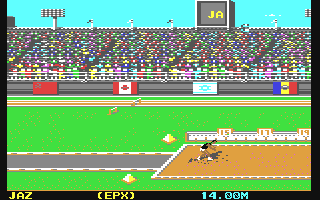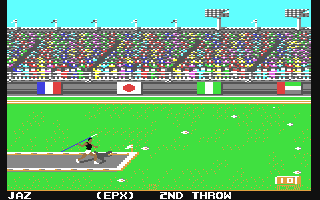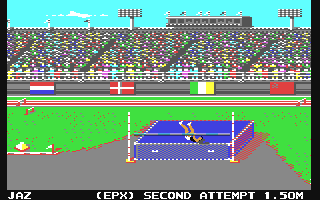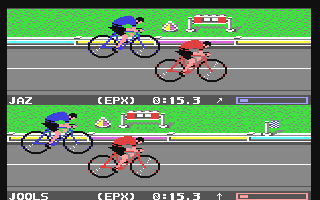|
This is one of the first of US Gold's freshly acquired
batch of Epyx games to be released in this country and
is the long awaited sequel to the highly acclaimed and
popular Summer Games, as marketed in Britain
by Quicksilva. Summer Games has been widely accepted
as the greatest of the multitude of sports simulations
available, since its release nearly a year ago.
Unlike
most of the genre, Summer Games didn't rely on
heavy (and sweaty!) joystick waggling sessions (apart
from the 100m dash, but that's only one event). Each
event had its own original control method that made
each of the eight different events challenging and fun
to play. There were a number of options to increase
enjoyment of play and up to eight people could compete
against each other. Summer Games II takes all
of these elements and adds to them.
As
with Summer Games there are eight events to compete
in for up to eight competitors with improved, and more,
options. A menu of eight (9 on the disk version), compared
with six on the original, appear on screen and can be
selected by joystick or keyboard. You can compete in
either one, some, or all of the events, or practice.
One or two joysticks may be used (for head to head play)
and there is a high score table of world records that
can be viewed at any time, as any world records achieved
are saved to disk for posterity (or to show off to a
few people). When using two joysticks, the program utilises
the same 'intelligence' utilised in Pitstop II,
ie any player can use whichever joystick port they so
desire by simply pressing the button of the stick they
wish to use. It is also possible to see the opening
ceremonies again, or even the spectacular closing ceremonies.
Another option, only present on disk, is the
ability to merge it with Summer Games so that
you can play a mammoth sixteen events in one go!
Each
event takes up a large amount of memory and so has to
be individually loaded in via disk or cassette. The
disk version takes up two sides of a diskette with four
events to each side (the computer prompts you as to
which side of the disk is to be used). When practising
an event you can play away to your heart's content and
have unlimited goes in a row, but any mega-records achieved
won't be saved to disk. If you compete in events, on
the other hand, each game you play is a sort of one-off,
but at least any cool scores will be saved out (for
scoring details, see panel piece). And after all that
-- onto events. . .
TRIPLE
JUMP
The first of the eight events has you hopping, skipping
and jumping your way to the record books, beneath the
critical eye of an enthusiastic crowd and the sweltering
heat of the stadium. The whole thing is seen from a
spectator's point of view -- the track and other members
of the crowd are visible along with a few bits of sports
equipment left lying around and the flags of all countries
along the edge of the stadium.

The
event starts with your athlete poised for action and
swaying with anticipation, his shadow mimicking his
lively motions. A piece of music is played as he limbers
up, before a press of the fire button sends him on his
way, the screen scrolling with the player as he pounds
down the track. As soon as the player hits the line,
four deft moves of the joystick are needed -- one for
the hop, the skip, and the jump. A further push is required
to give extra boost in flight. Critical timing is of
the essence and quick judgement and reflexes are necessary.
A successful jump results in a roar of approval from
the crowd and an instant replay on a small monitor at
the top of the screen.
The
judges will declare a fault should you overstep the
line or perform a movement too late. In competition
you are given three attempts to prove your worth, in
practice mode you can jump as many times as desired.
ROWING
The second event on the list has you rowing your way
to victory against the computer or another player. You
are initially presented with a split screen view of
two boats (similar to Pitstop II except this
is a plan view) along with a jaunty piece of music.
As with Pitstop II you can select to be either
the top or bottom player by pressing the fire button
when instructed. After a quick ready, set, GO! countdown,
the race is on.

The
course is 250 metres and must be completed in the quickest
time possible. The joystick is used to row, with left/right
strokes to raise the oars and to push them through the
water. A good rhythm is required throughout the race
in order to excel. Both screens scroll with each player
as he or she makes their way down the course, past the
distance markers and buoys (which bob up and down as
the boats pass)! Each player's course time is displayed
next to a speedometer which shows the player's speed.
JAVELIN
The javelin takes place in the stadium before the crowd.
Unlike your average Decathlon style event, there's
no joystick waggling required -- well, there is some
frantic button pressing involved.
Your
athlete starts in a similar manner to that of the triple
jump -- poised to go, with a jiggle in his walk and
a javelin in his hand and music in the background. A
press of the fire button sets him in motion and rapid
and persistent pressing gets him burning it over the
cinders. As the athlete (complete with shadow) runs
to the line, the screen scrolls with him and the javelin
bounces in time with his stride.

The
line approaches, and a well-timed tug of the joystick
is needed to break his stride and send the spear on
its path through the air. The angle of launch is determined
by how long the joystick is held left. This angle is
as important as the speed of the throw, if not more
so -- too high or too low a release will shorten the
length of time that the javelin flies.
If you cross the line before throwing then you will
have incurred a fault and the throw is void, but after
a successful throw you will find the crowd more than
a trifle appreciative. There are three throws in competition
and as many as you wish when practising.
EQUESTRIAN
Horse riding on a computer? You bet! In this exciting
event you not only control the horse but the rider as
well! The object: get round the jumps without incurring
faults against the clock. At the start a press of the
fire button gives you a five through one countdown and
. . . yeroff! Like the field events, this is from the
spectators' view, the course scrolling right to left.
A sense of depth is created through parallax movement
in three sets of background scenery scrolling at different
speeds. The scene is set by the various tents and waving,
clapping, or jumping spectators. The jumps are detailed
too, ranging from simple fences to walls, multiples,
and water jumps.

Pushing
forward on the joystick increases the horse's speed
and to jump fences you can either press the fire button
(medium jump) or push right (longer jump). Clipping
a fence or landing badly will cause the horse to stumble
and fall along with your rider. This incurs a minor
penalty (your current number of faults is shown at the
bottom of the screen along with the time taken so far).
A quick press of the fire button and an increase in
speed soon gets you on your way again though. To prevent
the horse stumbling on landing you need to pull back
on the reins using the joystick.
If
you attempt to jump a fence too early or far too late,
the horse will refuse to jump and your score is affected
badly. After which you must turn the horse round and
take another stab at the fence. Obviously, split-second
timing, concentration and a cool head are needed, as
is the case with all of the events.
The
course must be completed within the optimum time of
fifty seconds, since for each second over this time
limit you incur one penalty point. If your time exceeds
100 seconds then you are disqualified. The same happens
if your total points from faults exceed 99. At the end
of the course you are shown exactly where you went wrong
and course time is shown along with any faults gained
along the way and your overall score (faults). The lower
your score, the better, as this means that you incurred
minimal faults and completed the course quickly.
HIGH
JUMP
Yet another event that will offend the wagglers among
you -- no blood and sweat, just the tears when you shatter
your personal best. The high jump presents you with
the usual view of the stadium and your athlete poised
eagerly and raring to go once you have selected the
height at which you wish to attempt. The bar is initially
set to 1 .5m and you can accept it or go for something
higher, up to a maximum of 2.5m. Again the fire button
sets your player in action, but this time continual
pushes right with the joystick are required to get him
sprinting.

As
you pound down the track you can move nearer to, or
further away from, the bar. When you actually reach
the bar, a press of the button gets your athlete jumping,
and a further push on the stick gets him sailing over.
As you may have gathered, timing is crucial. Pressing
the button too late means that you just run past the
bar and get the chance to jump again (you aren't penalised
for this, though). On clearing a height you receive
due appraisal from the crowd and the bar is raised to
the next height. You have three attempts at clearing
a height and knocking the bar off from jumping too early,
too late, or too low results in a fault (no DT bugs
in this game, John). Practice mode, on the other hand,
allows you to attempt any height for as many times as
you wish.
FENCING
Fencing is one of the three optional head to head events
out of the eight, and is a sort of Exploding Fist
with swords. The event takes place indoors and is
viewed this time through the eyes of the referee, complete
with his computer, VDU and even a disk drive! Either
one or two players may take part, a droid taking the
part of the second player in the one player option.
When practising, this droid can be taken on at one of
five skill levels -- skill levels one to four (increasing
in skill) and a random skill when the droid becomes
slightly unpredictable.

The
bout takes place on the 'fencing piste'. A timer in
the bottom right of the screen counts down from three
minutes, and the first player to score five hits against
their opponent within this limit is declared the winner.
There are a wide range of manoeuvres at your disposal
and all must be used to their full to become proficient
at this event. You can move towards or away from the
other player, thrust, parry (block) and perform defensive
sweeping motions. Attacking moves are easily performed
by holding down the fire button and moving the joystick.
Defensive moves are obtained without the aid of the
button.
If
two players hit each other simultaneously then the hits
are nullified. When a player retreats too close to the
edge of the piste, a hit is scored against them.
The number of hits scored against each player are shown
on the referee's computer screen in the form of a mini
table along with the player's name and nationality.
If both players have tied at the end of the allotted
time limit then a sudden death fence-off takes place
-- the first player to score a hit is declared the winner.
If neither player should accomplish this, then both
are assessed a 'loss'. Strategy plays an important role
as well as the essential speed of thought and quick
reactions.
CYCLING
This is the only event that comes nearest to actual
waggling -- a sprint cycle race over a 200m course.
The display is twin-screen similar to the rowing event,
each display seen from a spectators' point of view.
The two cyclists appear in both displays (one red, one
blue) while a fitting rendition of Flight of the
Bumble-Bee buzzes merrily along. After deciding
which player is which (by pressing the respective fire
button) you are given a ready, set, GO! countdown.

At
the bottom of each display is the player's name, a speed
bar and an arrow that spins round representing the movement
of the peddles. This is where the real skill comes in,
as you have to rotate the joystick in time with the
arrow to get your rider's leggies pounding furiously.
Simply keeping up with the arrow gives you a constant
speed, but to attain high speeds and good times you
have to 'lead' the arrow by rotating the stick just
ahead of it. 'Leading' or 'lagging' too much may cause
the cyclist to stop pedalling altogether! This is easily
done if you're not careful, and so the utmost concentration
is required to maintain steady high speeds. Each view
of the track scrolls along with the respective cyclist
who both bob up and down convincingly as they zip along
the course, passing buildings, distance markers, running
tracks, and other such things. The first person to cross
the line in the shortest time is the winner.
KAYAKING
This is probably the most taxing and frustrating of
all the events as you battle your way downstream in
the perilous waters, through the long and winding course,
to cross the finish line in record time. Although there
isn't any frantic waggling involved, paddling your kayak
efficiently demands a high degree of mental and physical
strain.
The
course, viewed from above, is several screens' length,
the banks being littered with waving spectators, various
buildings, and other befitting scenery. The kayaks (a
sort of canoe) are steered through fifteen sets of 'gates'
spread along the course, in as quick a time as possible.
This isn't as easy as it may appear since the river
is very fast flowing and it's very easy to get drawn
off course. There are also several little islets that
get in the way and must be avoided.

Three
different types of gate are used, each composed of two
flags, one of which is always red. The red flags must
be kept to the player's left otherwise a twenty-second
penalty is incurred in conjunction with a little beep.
Penalties are also given if a player goes through the
same gate twice. Most of the gates are of the DOWNSTREAM
NORMAL variety, ie the player goes through them facing
down-stream, but there are DOWNSTREAM REVERSE gates
(steered through facing backwards) and UPSTREAM gates
(pass the gate, turn, and go through facing upstream).
You
paddle the kayak through pushes of the joystick. Forward
paddles you in a forward direction, back backwards and
so on, and each stroke is accompanied by a splash or
two to complement the fast flowing sounds of the river.
This sort of control proves very realistic and effective,
as a single push for each stroke is required -- holding
the joystick in any one direction doesn't get you anywhere!
Once
you cross the finish line you are shown a mini map of
the course along with a comment on how you fared at
each gate. Any penalties picked up along the way are
shown against the respective gate and are totted up
at the bottom of the screen. The total points gained
through penalties are added to the overall course time
to give your final score at the bottom of the screen.
|